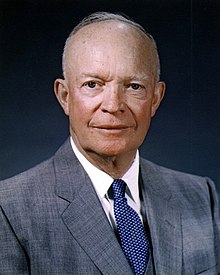General Eisenhower
| Dwight D. Eisenhower | |
|---|---|
 |
|
| 34th President of the United States | |
|
In office January 20, 1953 – January 20, 1961 |
|
| Vice President | Richard Nixon |
| Preceded by | Harry S. Truman |
| Succeeded by | John F. Kennedy |
| 13th President of Columbia University | |
|
In office 1948–1953 |
|
| Preceded by | Frank D. Fackenthal (Acting) |
| Succeeded by | Grayson L. Kirk |
| 1st Supreme Allied Commander Europe | |
|
In office April 2, 1951 – May 30, 1952 |
|
| President | Harry S. Truman |
| Deputy | Arthur Tedder |
| Preceded by | Position established |
| Succeeded by | Matthew Ridgway |
| 16th Chief of Staff of the Army | |
|
In office November 19, 1945 – February 6, 1948 |
|
| President | Harry S. Truman |
| Deputy | J. Lawton Collins |
| Preceded by | George Marshall |
| Succeeded by | Omar Bradley |
| Governor of the American Zone of Occupied Germany | |
|
In office May 8, 1945 – November 10, 1945 |
|
| President | Harry S. Truman |
| Preceded by | Position established |
| Succeeded by | Joseph T. McNarney |
| Personal details | |
| Born |
Dwight David Eisenhower October 14, 1890 Denison, Texas, U.S. |
| Died | March 28, 1969 (aged 78) Washington, D.C., U.S. |
| Cause of death | Congestive heart failure |
| Resting place | Dwight D. Eisenhower Presidential Library, Museum and Boyhood Home |
| Political party | Republican |
| Spouse(s) | Mamie Doud (m. 1916) |
| Children | |
| Alma mater | United States Military Academy |
| Signature | |
| Military service | |
| Allegiance |
|
| Service/branch |
|
| Years of service | 1915–1953 1961–1969 |
| Rank |
|
| Battles/wars | |
| Awards | |
![]() United States Army
United States Army![]() Quartermaster
Quartermaster![]() Engineer
Engineer![]() Armor
Armor
Dwight David "Ike" Eisenhower (/ˈaɪzənhaʊ.ər/ EYE-zən-how-ər; October 14, 1890 – March 28, 1969) was an American politician and Army general who served as the 34th President of the United States from 1953 until 1961. He was a five-star general in the United States Army during World War II and served as Supreme Commander of the Allied Expeditionary Forces in Europe. He was responsible for planning and supervising the invasion of North Africa in Operation Torch in 1942–43 and the successful invasion of France and Germany in 1944–45 from the Western Front.
...
Wikipedia
